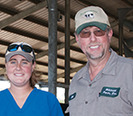
In years past, while milking in the parlor, labeling an animal as a cull cow was pretty straightforward. We were milking around 390 cows on average, were overstocked, and had a good number of replacement heifers always coming in. We weren’t as seasonal in calvings like we once were before we put up the freestall barn. So, we had a pretty even flow of about one to two calves born a day at all times.
In that situation, it was pretty easy to figure out who we needed to cull. In fact, we put some criteria about what cows should be culled into the computer. This made it so easy that we could get on PC Dart, grab the “cows that need to be culled” list, and go from there. This list was generated based on a few different factors: days in milk, reproductive status, milk production, how many times bred, mastitis history, and somatic cell count (SCC) information from test day sampling. This list already had the thinking done; we could just print it and go. If we happened to have a whole truckload going out one week it wasn’t that big of a deal because we knew seven or so cows would be calving in that week.
Things have changed since downsizing the herd and switching to robots. The surplus of replacement heifers has reduced since the number of cows milking has reduced. We no longer have a test sampling day. Changing the number of cows per robot by just a couple head can be detrimental if not done cautiously.
The old “cows that need to be culled” list is out the window. We can no longer go by this list for a couple of reasons. One is that we can’t cull as loosely as we used to because we have fewer cows. Another reason is that if the cows are doing well this week at 62 head per robot, and there are five cows we probably need to sell but not five cows to replace them from calving, then we might think twice about selling the five cows this week.
We also look at udder confirmation a lot more than we used to. If a cow comes in as a heifer and has five teats, a human is no longer looking at that fifth teat and recognizing that it’s not the one to hook up because there is no milk in it. That cow might have become 130 pounds per day producer in our milking parlor, but we can’t keep her in the new facility because the robot might not be able to attach her properly.
We do not have a test day SCC to go by. Now we might now sell a high-producing, capable cow that refuses to go to the robot on her own instead of the cow that is giving an average amount of milk with more days in milk, but she is continuously going to the robot without being fetched.
Our definition of a cull cow has evolved throughout the years. As the farm changes from year to year, we change our thinking and doing.

Mark and Caitlin Rodgers are dairy farmers in Dearing, Georgia. The Rodgers have a 400-cow dairy that averages 32,000 pounds of milk. Follow their family farm on Facebook at Hillcrest Farms Inc.










